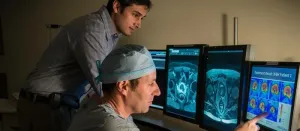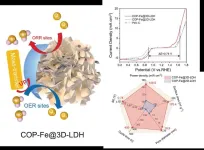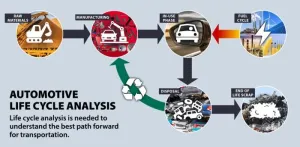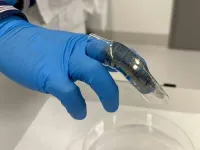(Press-News.org) A new Corewell Health study suggests that men who have longer prostatic urethras, the part of the urethra that travels through the prostate, may be at a higher risk of experiencing moderate, often chronic urinary side effects after receiving radiation for prostate cancer.
To date, researchers have struggled to determine any risk factors that could shed light on who might experience these types of side effects ahead of time. But now, a simple MRI scan and a new metric to determine urethra length could change that.
Results, now published in the journal Academic Radiology, indicate that for every 1-centimeter increase in length of the prostatic urethra shown on the MRIs of 361 men, patients were about 60% more likely to experience issues such as having the urgency to urinate as well as needing to urinate more often. Patients with a prostatic urethra length greater than 4.6 centimeters were nearly twice as likely to develop these symptoms.
“We believe this particular area is more exposed to the radiation doses patients receive, resulting in direct inflammation,” said Kiran Nandalur, M.D., principal investigator of the study and a radiologist at Corewell Health. “While chronic moderate urinary side effects were more problematic in approximately 28% of participants after three years, the good news is less than 3% of men experienced severe urinary side effects.”
According to Dr. Nandalur, there are very few known risk factors for those who will experience side effects after radiation and, in his study, factors such as type of radiation or underlying medical conditions were not predictive of symptoms. He said this underscores how challenging it has been previously to assess risk factors and highlights the need for novel and innovative methods such as the use of MRI technology in prostate cancer care.
Radiation therapy is one of the most common treatments for prostate cancer and overall, it is considered very safe. However, while radiation therapy is well tolerated by most patients, the portion of men who experience more side effects often can find their quality of life impacted for periods of time.
“Our novel MRI metric may help patients know beforehand what their risk is in developing these symptoms and help them make better and more informed decisions on a course of treatment that optimizes quality of life,” Nandalur said.
He added: “Doctors also can look at ways to better spare the prostatic urethra area from radiation and potentially decrease the side effects.”
Dr. Nandalur encourages patients to be proactive in their health and with their doctors.
“I highly recommend patients talk with their urologist or radiation oncologist about getting a prostate MRI before therapy,” he said. “It is robust in diagnosing and evaluating the extent of prostate cancer and can potentially help patients maintain a better quality of life after undergoing treatment.”
Additional Corewell Health authors on the study include Joseph Lee, M.D., Ph.D.; Sirisha Nandalur, M.D.; Allison Hazy, M.D.; Sayf Al-Katif, M.D.; Hong Ye, Ph.D.; Nathan Kolderman, M.D.; Abhay Dhaliwal, M.D.; Daniel Krauss, M.D.; Thomas Quinn, M.D.; Kimberly Marvin; and Kyu Kim, B.S., with the Oakland University William Beaumont School of Medicine.
About Corewell Health™
People are at the heart of everything we do, and the inspiration for our legacy of outstanding outcomes, innovation, strong community partnerships, philanthropy and transparency. Corewell Health is a not-for-profit health system that provides health care and coverage with an exceptional team of 60,000+ dedicated people—including more than 11,500 physicians and advanced practice providers and more than 15,000 nurses providing care and services in 21 hospitals, 300+ outpatient locations and several post-acute facilities—and Priority Health, a provider-sponsored health plan serving more than 1.3 million members. Through experience and collaboration, we are reimagining a better, more equitable model of health and wellness. For more information, visit corewellhealth.org.
###
END
They published their work on Oct. 12 in Energy Material Advances.
"The development of cost-effective and high-performance zinc-air battery cathode catalyst is imperative," said paper author Zhonghua Xiang, professor with the Beijing University of Chemical Technology. "Currently, zinc-air batteries still not occupy the market, because they are limited in both stability and in their energy density."
Xiang explained that zinc-air batteries can only work for very limited time at high current density, because there are lots of problems of its cathode, anode and electrolyte.
"The air ...
Annapolis, MD; October 18, 2023—Every so often, cicadas emerge above ground and blanket the earth with their exoskeletons while emitting a high-pitched chirp from sunrise to sunset. The periodical cicadas in the genus Magicicada come every 13 or 17 years, though other types of cicadas emerge much more frequently in our neighborhoods. A long-standing agricultural query related to the periodical cicadas was recently answered by an Agricultural Research Service (USDA-ARS) research team at West Virginia's Appalachian Fruit Research Station. Simply: Once periodical ...
SAN ANTONIO — October 18, 2023 —Southwest Research Institute will host the Life-Cycle Analysis for Transportation Symposium on Nov. 16-17 in San Antonio. This year’s symposium will be in person for the first time.
The two-day event will highlight academic, industry and institutional research efforts to characterize the total greenhouse gas emissions produced during the entire life cycle of a vehicle, including its manufacture, service life and recycling or disposal.
“We often talk about getting to ‘zero-emissions,’ but this definition often ...
Media Contact: Kara Flynn, 202.257.8424, press@ashg.org
For Immediate Release: Wednesday, October 18, 2023, 10:00am U.S. Eastern Time
ROCKVILLE, MD — More than ever before, human genetics and genomics is an essential part of making progress in research, biotechnology, and health. As a key leader supporting research innovation, the American Society of Human Genetics (ASHG) will convene more than 8,000 researchers and clinicians at the ASHG 2023 Annual Meeting in Washington DC, Nov. 1-5 to share emerging discoveries and celebrate the Society’s 75th anniversary.
“Human genetics is transforming science and health at a rapid ...
More than 150 species of wild animals across every continent are contaminated with flame retardant chemicals, according to a new map tracking peer-reviewed research worldwide. Polluted wildlife include killer whales, red pandas, chimpanzees and other endangered species. Added to furniture, electronics, vehicles, and other everyday products to meet flammability standards, the chemicals often do not work as intended. They also migrate out of products and into wildlife—and people.
“Flame retardants don’t actually make TV enclosures and car interiors more fire-safe, but they can harm people and animals,” ...
Octopuses are fascinating animals – and serve as important model organisms in neuroscience, cognition research and developmental biology. To gain a deeper understanding of their biology and evolutionary history, validated data on the composition of their genome is needed, which has been lacking until now. Scientists from the University of Vienna together with an international research team have now been able to close this gap and, in a study, determined impressive figures: 2.8 billion base pairs - organized in ...
A collaborative research team, led by Professor Hyun-Kon Song in the School of Energy and Chemical Engineering at UNIST, Dr. Seo-Hyun Jung from Research Center for Advanced Specialty Chemicals at Korea Research Institute of Chemical Technology (KRICT), and Dr. Tae-Hee Kim from the Ulsan Advanced Energy Technology R&D Center at Korea Institute of Energy Research (KIER), has achieved a groundbreaking milestone in battery technology. Their remarkable achievement in developing a non-flammable gel polymer electrolyte (GPE) is set to revolutionize the safety of lithium-ion batteries (LIBs) by ...
SPOKANE, Wash. – A two-part training designed to help police officers recognize their implicit bias, revealed some behavior improvement and lowered citizen discrimination complaints in a controlled study. While a small study involving one police department, it is the first-known research to provide evidence that this type of training can produce positive behavioral effects.
Led by Washington State University researcher Lois James, the study found some improvement in the anti-bias trained officers’ behavior toward homeless people in particular, ...
Researchers have invented an experimental wearable device that generates power from a user’s bending finger and can create and store memories, in a promising step towards health monitoring and other technologies.
The innovation features a single nanomaterial incorporated into a stretchable casing fitted to a person’s finger. The nanomaterial enabled the device to generate power with the user bending their finger.
The super-thin material also allows the device to perform memory tasks, as outlined below.
Multifunctional devices normally require several materials in layers, which involves the time-consuming challenge of stacking nanomaterials with high precision.
The team, led ...
Determining whether a person is diabetic could be as easy as having them speak a few sentences into their smartphone, according to a groundbreaking study from Klick Labs that combines voice technology with artificial intelligence in a major step forward in diabetes detection.
The new study, published in Mayo Clinic Proceedings: Digital Health, outlines how scientists used six to 10 seconds of people’s voice, along with basic health data, including age, sex, height, and weight, to create an AI model ...










